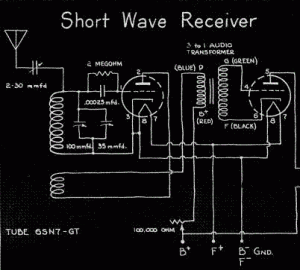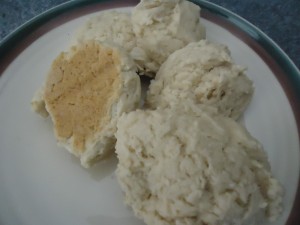
 My BaoFeng UV-5R
My BaoFeng UV-5R arrived today, and I’m quite impressed with what I’ve seen so far. The radio is pictured here. For some reason, the Amazon picture shows a European-style plug adapter next to it, but understandably, this was not included. For just over $35, I received the radio
arrived today, and I’m quite impressed with what I’ve seen so far. The radio is pictured here. For some reason, the Amazon picture shows a European-style plug adapter next to it, but understandably, this was not included. For just over $35, I received the radio and the separately purchased programming cables. The radio itself included the antenna, the battery and charger, a headphone which apparently doubles as a through-the-ear microphone, and a belt hook and carrying strap. The cable included a little disc with the drivers, but apparently no programming software.
and the separately purchased programming cables. The radio itself included the antenna, the battery and charger, a headphone which apparently doubles as a through-the-ear microphone, and a belt hook and carrying strap. The cable included a little disc with the drivers, but apparently no programming software.
Since I’m a ham, immediately upon opening the box, I moved the little manual aside, installed the battery and antenna, and turned it on. I grabbed another handheld, my Yaesu VX-3R in order to test the new radio. There was an orange button marked VFO/MR, which I correctly assumed switched between memory and VFO mode. I put the radio in VFO mode and proceeded to enter a frequency, 146.520. Sure enough, it tuned in the frequency, but I noticed that the radio put itself on 146.500 instead of 146.520. Undaunted, I tuned the other radio to that unusual frequency and determined that the new radio could, indeed, both transmit and receive. It didn’t sound half bad.
After a bit of trial and error with the keypad, I determined that the radio must be set for 25 kHz channel spacing. To changed the channel spacing, I correctly surmised that the “MENU” button would probably be required. I pushed it, and it showed me that I was on menu #0, used for setting the squelch. Using the up and down buttons, I found a menu entitled “STEP”. and hit the menu button again. Sure enough, the radio’s built in voice announced “frequency step”, and I used the up and down buttons until the display read 5.0K. I hit “MENU” again, and the voice told me “confirmed”. I hit “EXIT” and tried entering the frequency again. Lo and behold, this time, 146.520 took when I entered it.
Emboldened by my ability to enter the frequency, I decided to try a local repeater. I successfully entered the output frequency, 146.850. I then started scrolling through the menus looking for a method to enter the offset frequency. I found a menu reading “OFFSET 00.000”, and I correctly surmised that I needed to change this to 00.600, which I was able to do quite easily. Unfortunately, I had to resort to the manual to determine how to turn the shift on and off. It turns out that menu item is named “SFT-D”, which I’m told stands for “direction of frequency shift”. I set this to minus. Upon hitting the push-to-talk button, the display read 146.250. And upon releasing it, the squelch tail of the repeater came back to me.
I put out a call, but nobody was around. Therefore, I gave my wife the other radio and tried to work her. Interestingly, I was making the repeater quite well, but the VX-3R, with less power and a smaller antenna, was extremely noisy. She could hear me, but I couldn’t hear her.
Another ham came back to me and gave me a favorable signal report. It turns out he was also using the same radio, and he congratulated me on getting the thing to work without resorting to the programming software.
Since this radio isn’t really designed for amateur use, it’s not really optimized for things such as repeater splits. Therefore, I realized that to get the full potential, I would need to program it, which is why I ordered the programming cable. Before resorting to the software, though, I decided to try out the receiver. As expected, it received the NOAA weather broadcast on 162.55 MHz quite well. But much to my surprise, it also received signals from Clearwater, Minnesota, and Red Wing, Minnesota with just the rubber duck antenna. In short, the receiver seems to work quite well.
Programming the radio with the computer wasn’t particularly difficult, but I did have a couple of false starts. The guy I worked on the repeater warned me something about when I should turn the power on. I forget whether he said that I should turn the radio on before or after I hooked it to the computer. He also said something about using the COM3 port with the Chirp software.
I downloaded the Chirp software from http://chirp.danplanet.com/projects/chirp/wiki/Home. In my exuberance, I didn’t really pay attention to what I was doing. I dutifully clicked on a big green button marked “download”. After downloading some worthless software that slowed down the computer until I uninstalled it, I realized that this was just an advertisement, and I had to actually click on the correct text link. So after uninstalling the worthless software, I got Chirp installed uneventfully.
I plugged in the radio, but the program apparently had nothing to communicate with. It turns out I had to install the driver software from the little disk that was included. I did so, and was getting closer to programming the radio.
I had a few more false starts. When the software still didn’t seem to be communicating, I remembered the other guy’s comment about the COM3 setting. I changed this, and it seemed to help. However, I still wasn’t able to communicate with the radio, even though the lights did seem to be flashing in some random fashion.
I tried jiggling various wires. And remembering the other guy’s comment about the power, I tried various strategies, such as turning the power on, then plugging into the USB port, or vice versa. None of these seemed to work. Eventually, however, I realized that there was also an option for “COM4” in the software. Sure enough, this one worked. I was able to upload the radio’s current configuration to the computer. And after I did so, I then had the option to download any changes I made.
The Chirp software is very intuitive, and I think I figured it out without recourse to any documentation.
I programmed in one repeater, one simplex channel, and NOAA weather. When I programmed in NOAA, I set the corresponding transmit frequency to inside the ham band, and with low power. It would be very easy to transmit out of band with this thing, and that step should prevent it from happening, at least when I’m using one of the memory channels.
I also programmed in some satellite frequencies, for the SO-50 LEO satellite. I’ve never really operated any satellites, but I want to give it a try, and I may as well try it with this radio. There’s an excellent primer on the subject at www.work-sat.com. At this point, I don’t have any way of connecting an external antenna. The radio, it turns out, has a “reverse” SMA connector. In other words, the radio has a male connection, and the antenna has a female connection. Since I don’t have the correct connector on hand, I’ll have to use the rubber duck antenna for the time being. But I know that people have worked the FM satellites using just a rubber duck antenna, and I intend to give it a try.
FInally, I did a bit of reading on the web about my new toy. The best site I’ve found so far is http://www.miklor.com/uv5r/. In particular, that site contains an expanded version of the manual. After getting familiar with the radio, I did sit down and read through the manual.
Overall, my first impression of this rig is that it’s an extraordinary value for the money. It seems well built and extremely versatile. I was very impressed with the quality of the receiver, and it seems to get out just fine.
Unfortunately, most people who buy this sort of radio seem to use it for little more than chatting on repeaters. While that can be fun, the novelty wears off quite fast. It seems to me that there are many more fun things that can be done with this radio, and over the next few weeks, I’ll let you know what some of them are.
I found an interesting construction article for a one-tube regenerative receiver in the September 1950 issue of Boys Life magazine. (From this link, you’ll need to scroll down to page 56 to read the article.) The authors are listed as Fred Roden and Glenn A. Wagner, and it reports the receiver in use at Albany, NY, where it picked up London, England, “clear and strong.” According to the 1952 Call Book, Roden was W2KED. He’s also listed as trustee of a Colubmia High Radio Club, W2OML, in East Greenbush, N. Y. Wagner seems to have been an author of many hobby articles for Boys Life, but I couldn’t find any indication that he was a licensed ham.
and China
. This audio transformer should be close enough if you want to stick to the Boys Life/Handbook version. Otherwise, you can go with the AA8V design, which seems to use only readily available components.




















